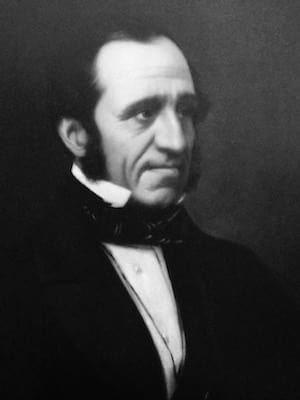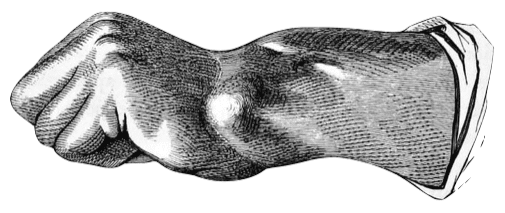Robert William Smith

Robert William Smith (1807-1873) was an Irish surgeon and pathologist.
A multitalented physician, he was; an astute linguist, a dynamic teacher, a medical historian and surgical pathologist publishing on topics ranging from arthritis to neuroma
The first Professor of Surgery at Trinity College when it was established in 1847. Eponymously affiliated with the Smith Fracture
Although he practiced surgery, his primary interest was in pathological anatomy. His reputation as a pathologist was so great that Abraham Colles requested that Smith be called upon to perform Colles’ own autopsy. The autopsy was performed and later published by later published in William Stokes’s ‘Observations on the Case of the Late Abraham Colles‘
Biography
- Born October 12, 1807, Dublin
- 1832 – Licentiate of the Royal College of Surgeons of Ireland
- 1838 – Co-founded the Pathological Society of Dublin along with Colles, Graves, Corrigan and Stokes
- 1847 – First chair of surgery at Trinity College; published his treatise on fractures, described as ‘the most important work on fractures in English since Sir Astley Paston Cooper (1822)
- 1849 – Smith published a monograph ‘A Treatise on the Pathology, Diagnosis and Treatment of Neuroma‘
- 1870 – Professor of Surgery at Trinity College, Dublin
- 1873 – Vice-President of the Royal College of Surgeons of Ireland
- Died October 28, 1873, Dublin
It is, I conceive, the duty of every person who undertakes to write upon a given subject, to make himself, as far as possible, acquainted with, and also to acknowledge the labours of those who may have preceded him in the same field of inquiry
Smith, 1847
Medical Eponyms
Smith fracture (1847)
Extra-articular fracture of the distal radius with associated palmar (volar) angulation of the distal fracture fragment. Also called Goyrand fracture or reverse Colles fracture.
Smith Original description and Drawing
This is an injury of exceedingly rare occurrence, and one which presents characters closely resembling those of dislocation of the carpus forwards. It generally occurs in consequence of a fall upon the back of the hand, and the situation of the fracture is from half an inch to an inch above the articulation; it is accompanied by great deformity, the principal features of which are a dorsal and a palmar tumour, and a striking projection of the head of the ulna at the posterior and inner part of the forearm; the dorsal tumour occupies the entire breadth of the forearm, but is most conspicuous internally, where it is constituted by the lower extremity of the ulna displaced backwards; from this point, the inferior outline of the tumour passes obliquely upwards and outwards, corresponding in the latter direction of the lower end of the superior fragment of the radius. Immediately below the dorsal swelling there is a well marked sulcus, deepest internally below the head of the ulna, directed nearly transversely, but ascending a little as it approaches the radial border of the forearm.
Smith, 1847: 162

Key Medical Contributions
Smith’s treatise on fractures built on the initial work of Sir Astley Paston Cooper in further exploring the relative amount of shortening of the lower limb in intracapsular vs extracapsular femoral fractures. However he disagreed with some of Cooper’s findings.
Sir Astley Cooper, Amesbury, Chassaignac, Vidal (De Cassis) and others maintain that the shortening is greater in the intracapsular fracture than in the extracapsular.
I do not think so, and I feel satisfied that the degree of shortening of the limb may, with certain precautions, be considered as diagnostic of the seat of the fracture, and that it is greater when the lesion of the bone is external to, than when it is within the capsular ligament.
Smith RW. A Treatise on Fractures in the Vicinity of Joint and on Certain Forms of Accidental and Congenital Dislocations. Dublin: Hodges Smith. 1847.
It was Smith who was responsible with attaching his friend and colleague Abraham Colle’s name to the most common fracture of the wrist
In this country, the name of an eminent surgeon, lately deceased, has been associated with this injury; we know it here as Colles’s Fracture of the Radius.
Smith 1847;129
Smith also refines Colles’ description of the fracture by placing the site of Colles’ fracture more distally.
The situation of the fracture is not so high as Mr Colles’ states it to be; I have never seen it more than an inch above the carpal end of the bone; in the majority of cases it is not so much.
Smith RW. On Fractures of the Bones of the Fore-arm in the Vicinity of the Wrist Joint. Dublin, Hodges Smith. 1847: 129-175
Smiths treatise on neuroma was perhaps his most notable and definitely his most unique. It contained an extensive review of the literature as well as his own observations. The book included a full description of generalized neurofibromatosis, including a description of von Recklinghausen syndrome (neurofibromatosis Type I) over 30 years before von Recklinghausen described it. It contained 2 cases of patients on whom Smith had dissected over 2,000 neuromas. The monograph itself is unusual, being an elephant folio measuring 48 x 70 cm, and is said to be the largest book ever published in Ireland up to that time. The illustrations were ‘drawn from life and on stone‘ and are for the most part life-size.
Controversies
The combination of Smith’s and Colles’ professional relationship and Smith’s expertise in Surgical Pathology meant that he was the ideal candidate to carry out Colles’ autopsy. Indeed Colles actually wrote a letter to Smith personally requesting that Smith carry out his autopsy and offering some insights into how exactly his health was failing him. The autopsy was later published by William Stokes as ‘Observations on the Case of the Late Abraham Colles‘
My Dear Robert,- I think it may be of some benefit, not only to my own family, but to society at large, to ascertain the exact seat and nature of my last disease. I am sure you will grant my request and see this carefully and early done. The parts of which I would direct your particular attention to are the heart and the lungs, a small hernia immediately above the umbilicus, and the swelling in the right hypochondrium.
Stokes W. Observations on the case of the late Abraham Colles MD: formerly Professor of Surgery in the Royal College of Surgeons of Ireland. Dublin Quarterly Journal of Medical Science. 1846;1(2)303–322
Major Publications
- Smith RW. An essay upon the original or congenital luxations of the upper extremity of the humerus. Dublin: Hodges Smith. 1839.
- Smith RW. A Treatise on Fractures in the Vicinity of Joint and on Certain Forms of Accidental and Congenital Dislocations. Dublin: Hodges Smith. 1847.
- Smith RW. On Fractures of the Bones of the Fore-arm in the Vicinity of the Wrist Joint. Dublin, Hodges Smith. 1847: 129-175. [Smith fracture]
- Smith RW. A treatise on the pathology, diagnosis and treatment of neuroma. 1849. [Re-print: Clin Orthop Relat Res. 1989;(245):3-9. PMID2502348]
- Smith RW. Observations upon chronic rheumatic arthritis of the shoulder. Dublin, Hodges Smith. 1853
- Smith RW. Case of supra-sternal luxation of the clavicle. Dublin: Falconer. 1872
References
Biography
- Peltier LR. Eponymic fractures: Robert William Smith and Smith’s fracture. Surgery. 1959 Jun;45(6):1035-42.
- Mostofi SB. Who’s Who in Orthopedics. Springer. 2005:309-310
- Shah HM, Chung KC. Robert William Smith: his life and his contributions to medicine. J Hand Surg Am. 2008 Jul-Aug;33(6):948-51.
- Cooney WP. Clinical Epidemiology of Orthopedic Trauma. LWW. 2010
Eponymous terms
- Stokes W. Observations on the case of the late Abraham Colles MD: formerly Professor of Surgery in the Royal College of Surgeons of Ireland. Dublin Quarterly Journal of Medical Science. 1846;1(2)303–322
- Peltier LR. Six eponymic fractures. Bull Med Libr Assoc. 1960 Jul;48(3):345-51.
- Zhang Y. Clinical Epidemiology of Orthopedic Trauma. Thieme. 2012
Eponym
the person behind the name
Dr Ronan McKenna, MB BCh BAO at National University of Ireland Galway. Living in Australia with plans for a future in Emergency Medicine. A keen interest in Medical History, Wilderness Medicine and Sport.

